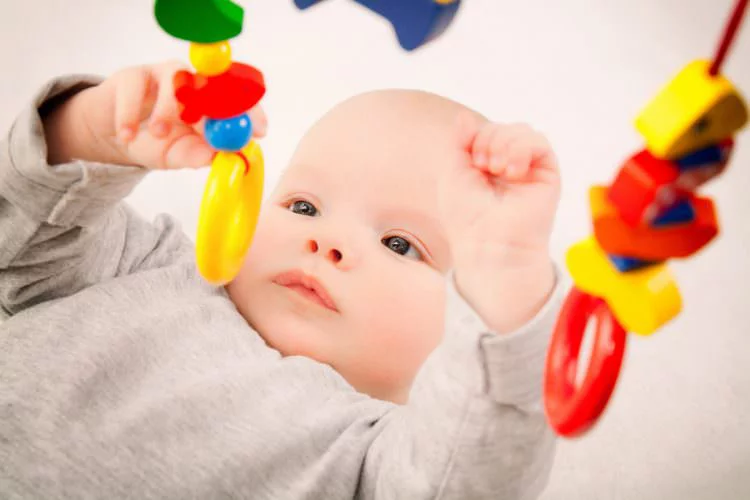Crawling, cruising, walking, and everything in between are on your 13-month-old’s physical development agenda. Alongside this, hand-eye coordination is improving, prompting the need to keep valuable (or hazardous) items out of reach. Your toddler’s vocabulary is blossoming, and you can aid this by describing your surroundings and activities. As her demands increase, coupled with a growing fear of strangers and separation anxiety, this month may present challenges. However, finding joy in these unpredictable days and nurturing your child’s development with patience and understanding can make all the difference.
Physical Development
Crawling, Cruising, and Walking
The age range for beginning to walk is wide for this gross motor skill compared to others. While most infants can lift their heads between 2 and 4 months, walking can occur as early as 9 months or as late as 15 months and still be considered typical.
As your child explores mobility – whether crawling, cruising, or walking – don’t be surprised if he becomes less keen on being held or carried. Once he experiences the freedom of movement, restraining him may prove challenging. (Trips to places like the grocery store might become particularly eventful!)
Don’t fret about shoes at this stage, as barefoot cruising and walking on various surfaces help strengthen the muscles in your toddler’s legs and improve balance. Expect falls as part of the learning process, and refrain from rushing to his aid unless necessary.
If your toddler is already walking confidently, encourage him to explore other physical activities, such as squatting without support. You can make it fun by incorporating it into a treasure hunt during walks.
Avoid using a “walker” to encourage walking, as they are considered unsafe and don’t aid in learning to walk.
Ensure safety around stairs by installing hardware-mounted safety gates. These are more secure than pressure-mounted gates.
Hand-Eye Coordination
Your 13-month-old is also honing her hand skills. Many children enjoy activities like putting objects into containers and then emptying them out. They may also enjoy building towers with blocks and knocking them down.
They often prefer exploring kitchen cupboards over toys. You can make this safer and engaging by childproofing most cupboards and leaving one open for exploration with safe items.
At mealtime, watch for signs of the pincer grasp as your child picks up small foods. She may also show interest in using a spoon, although it may not always lead to successful bites.
Remember, at this age, children are unaware of concepts like fragility or danger. Keeping breakables and hazards out of reach simplifies your life.
Language and Cognitive Development
Observation, Awareness, and Early Communication
Much like how he mimics your actions when you interact with the dog or tend to the garden, your 13-month-old is closely listening to your words and how you say them, eager to give it a try himself. Listen closely to his babbling; you’ll notice his intonation sounds conversational, even though he hasn’t spoken any words yet. When you ask him questions, he might respond with babbling and gestures, indicating his understanding of your communication cues. Notice how he reacts differently to your tones, whether it’s a frantic “no!” or a soothing request to stop tugging on your leg. These reactions signify his growing awareness of intonation in communication.
Children at this age are testing their powers of observation and understanding that objects exist even when out of sight. To test your child’s understanding of object permanence, try hiding a toy under the couch or a stuffed animal under a blanket for him to find.
As your toddler explores problem-solving, ensure your home is childproofed as he may attempt various actions like fitting objects inside others, turning switches, or twisting knobs without recognizing potential danger.
Vocabulary and Comprehension
Around 13 months, many toddlers have a vocabulary of three or four words, including “mama,” “dada,” “ta ta” for thank you, “ba” for bottle or ball, and “bye-bye.” However, if your child isn’t speaking yet, don’t worry; she’s absorbing language passively, storing information for later use. Even without clear words, she likely communicates her needs through gestures, sounds, and body language.
Encourage language development by labeling actions and objects, narrating daily activities, and using clear, simple speech with exaggerated pitch and intonation. Engage in interactive songs with gestures like “Itsy-Bitsy Spider” to make speech enjoyable and introduce music.
Listening attentively to your child’s “conversations,” maintaining eye contact, and responding with smiles and nods fosters her desire to communicate and teaches her valuable listening skills.
Behavioral Health and Development
Curiosity and Exploration
Your 13-month-old is likely finding joy in pushing, throwing, and knocking things down. This behavior isn’t meant to be deliberately destructive but rather stems from a curiosity about cause and effect – what happens if I do this? It’s all part of his exploration of the world, from unrolling toilet paper to pulling books off shelves.
Even interactions with people are experiments for him, which might lead to a hug followed by a bite or hit. While this phase may be challenging for you, remember that your toddler is not intentionally disobeying but rather discovering her environment and her influence over it.
With limited impulse control, your toddler may repeat behaviors you’ve just corrected. Offering alternatives, distractions, and choices can help set boundaries and avoid meltdowns while allowing her to explore and play freely.
Providing a safe play area without restrictions is key to establishing healthy boundaries. You can guide her energy into constructive activities:
Fun with Containers:
Games involving putting objects in containers and emptying them out can be engaging. Blocks in buckets, nesting containers, and pop-up toys provide entertainment and sensory stimulation.
Pillow Fights:
Safe pillow fights can tire out your toddler and provide a physical outlet for her energy.
Clay Creations:
Modeling clay offers opportunities for tactile exploration, from pulling and kneading to rolling and shaping.
Splashing Fun:
On rainy days, embrace the opportunity to jump in puddles together, allowing your child the freedom to splash and make a mess without restraint.
Social and Emotional Development
Assertiveness and Separation Anxiety
Your 13-month-old may seem self-absorbed, showing little interest in playing with other children. However, he still relies heavily on you for attention and comfort. While he’s gaining confidence in exploring independently, he may still need reassurance from you intermittently.
Stranger Anxiety and Other Fears
At this age, your toddler may exhibit separation anxiety, becoming upset when you leave, even with familiar caregivers. Additionally, he may develop fears of loud noises, bath time, or animals. Patience and acceptance of his emotions are crucial during these moments.
Social Skills
Encourage social development through interactive activities like hide-and-seek, fetch, and mimicking games. These interactions teach your toddler about sharing, taking turns, and responding to positive reinforcement.
Feeding and Nutrition
Small Appetite and Picky Eating
Your toddler’s once hearty appetite may diminish around this age, accompanied by newfound pickiness. This change is normal as their growth rate slows down. Avoid pressuring your child to eat more than they want. Instead, focus on offering a variety of healthy foods at every meal and letting them determine how much they eat.
Avoid turning mealtimes into battles. Pushing your child to eat more can have the opposite effect. Offer nutritious options and let your child choose what and how much they want to eat. If they refuse food, don’t force it; save it for later. Remember, picky eating is common and usually nothing to worry about as long as your child appears healthy and is growing well. If you have concerns, consult your doctor.
Sleep
Dreaming Begins (and Nights Can Get Busy Again)
Even if your child has been sleeping soundly for months, they may start waking up at night again around this age. While this can happen at any stage during infancy and toddlerhood, one new potential sleep disturbance at this age is vivid dreaming.
Toddlers may start actively dreaming, and a dream can startle them awake. Maintaining routines and establishing a beloved bedtime ritual can help in keeping your toddler’s sleep on track.
Play
Introducing Solo Play
It might be a while before your child learns to entertain themselves for an extended period (although some kids can do so now). You can start the learning process by encouraging them to play without your direct involvement occasionally.
Try showing your toddler how to play with a particular toy, then turning away for the few minutes that they may be absorbed with it. This helps teach them that they don’t need your interaction or direction every second.
When they become restless or ask for your help, turn back to them and reengage or introduce a new activity. Small increments of solo play help build confidence too.
Your Life
Getting Out of the House
The secret to leaving your home with a 1-year-old can best be summed up in two words: Be prepared. Whether you’re going a short distance or far away, bring a large diaper bag stocked for every eventuality.
That means lots of easy-to-handle snacks (like dry cereal, fig bars, or crackers), milk, water, plenty of diapers and wipes, a sweater in cool weather, two changes of clothes (in case of diaper blowouts, carsickness, or spills), extra clothes for you (you never know when you’ll become part of the mess), comfort objects (bear, blankie), and multiple diversions (such as board books, small toys, and finger puppets).



